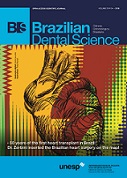Antimicrobial and mechanical acrylic resin properties with silver particles obtained from Fusarium oxysporum
DOI:
https://doi.org/10.14295/bds.2018.v21i1.1534Resumo
Objective: This study evaluated the effects of the incorporation of silver nanoparticles (AgNPs) obtained from Fusarium oxysporum on heat-activated acrylic resin (HAAR) and their influence on resin’s surface roughness, hardness, color alteration and antimicrobial capacity against Candida albicans. Material and Methods: For this, 50 discs of HAAR (2x5 mm) were produced and divided into three groups, Control: HAAR; Ag1: HAAR plus 0.539 mg of AgNPs; and Ag2: HAAR plus 1.1 mg of AgNPs. Knopp hardness (HK), surface roughness (Ra and Rz) and color alteration according to the CIE Lab were measured. Specimens were then evaluated in vitro with regard to C. albicans biofilm formation through formed colony count (CFU/mL). Scanning Electron Microscopy (SEM) and Atomic force microscopy (AFM) analyses were performed. Results: The addition of AgNPs of both concentrations changed Ra, Rz and HK significantly. There was statistically significant difference for L (p=0.00); a*(p=0.00) and b*(p=0.00) parameters. There were no differences between Ag1 and Ag2 biofilm formation, but the comparison of both with the control group presented a significant reduction (p=0.0091) on biofilm formation. SEM and AFM images showed no signs of NPs clustering. Conclusion: It can be concluded tha AgNPs incorporation in HAAR was effective in reducing C. albicans activity, with a slight change in color and hardness of the material, being effective therefore, in regions such as the dental prostheses palate, which have lesser aesthetic appeal.
Keywords
Acrylic resins; Silver; Antimicrobial agents.
Downloads
Downloads
Publicado
Como Citar
Edição
Seção
Licença
TRANSFERÊNCIA DE DIREITOS AUTORAIS E DECLARAÇÃO DE RESPONSABILIDADE
Toda a propriedade de direitos autorais do artigo "____________________________________________________________________" é transferido do autor(es) para a CIÊNCIA ODONTOLÓGICA BRASILEIRA, no caso do trabalho ser publicado. O artigo não foi publicado em outro lugar e não foi submetido simultaneamente para publicação em outra revista.
Vimos por meio deste, atestar que trabalho é original e não apresenta dados manipulados, fraude ou plágio. Fizemos contribuição científica significativa para o estudo e estamos cientes dos dados apresentados e de acordo com a versão final do artigo. Assumimos total responsabilidade pelos aspectos éticos do estudo.
Este texto deve ser impresso e assinado por todos os autores. A versão digitalizada deverá ser apresentada como arquivo suplementar durante o processo de submissão.




























